AI agent is an autonomous system designed to work on its own to complete specific tasks and reach set goals. It interacts with its surroundings, gathers information, and decides on actions to take based on the data it collects.
The evolution of AI agents has seen significant milestones, from early rule-based systems in the 1950s to today’s advanced models that use deep learning and large language models (LLMs), allowing them to operate autonomously in dynamic environments.
Definition of AI Agent
An AI agent is an autonomous system or entity that can sense its environment through sensors, process information, make decisions, and take action to achieve specific goals.
For example, a self-driving car AI could begin by navigating simple routes with minimal traffic. As it gathers more data from the environment (surrounding) and experiences various driving conditions, it would learn to handle complex scenarios like merging on highways, responding to sudden obstacles, or adjusting to changing weather conditions, making its decisions more efficient and accurate over time.
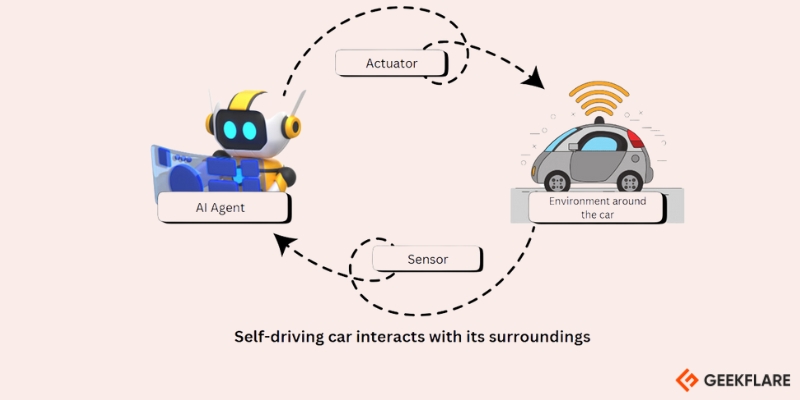
AI agents are like a smart assistant that learns and adapts over time. They can handle different tasks, make decisions on their own, and improve as they go. Like a customer service AI agent that answers questions and provides solutions, an AI agent can adapt to new information, make choices, and adjust its actions without needing constant human input.
Here is a difference between traditional AI and AI Agents:
| Aspect | Traditional AI | AI Agents |
|---|---|---|
| Goal or Purpose | Single-purpose algorithms | Multi-purpose, capable of handling many tasks |
| Decision Making | Static, follows predefined rules | Dynamic, adapts based on new data, interaction or conversation |
| Environmental or User Interaction | Limited, operates within controlled environments | Continuous, responds to real-time changes |
| Learning Ability | Limited or requires manual retraining | Autonomous, can learn and improve over time |
| Response | Predefined responses or based on fixed rules | Can generate responses based on learned patterns and added tools such as database |
| Human Oversight | Requires frequent human intervention | Operates autonomously with minimal oversight. But, humans can still control some things |
| Adaptability | Low adaptability, fixed in function | High adaptability, adjusts to varying conditions |
| Independence | Dependent on human inputs and oversight | Independent, capable of self-command |
AI Agents are flexible and can adjust to changing situations without needing constant updates. This makes them useful in areas like self-driving cars, healthcare, and finance, where things change quickly, and decisions need to be made on the spot.
How AI Agents Work?
AI agents are powered by large language models (LLMs), often referred to as LLM agents. Traditional LLMs generate responses based on the data they are trained on and are limited by their knowledge and reasoning abilities.
However, agentic technology improves this by using backend tools to gather up-to-date information, optimize workflows, and autonomously create subtasks to achieve complex goals. This allows the agent to adapt to user expectations over time. By storing past interactions in memory and planning future actions, the agent can offer personalized experiences and comprehensive responses.
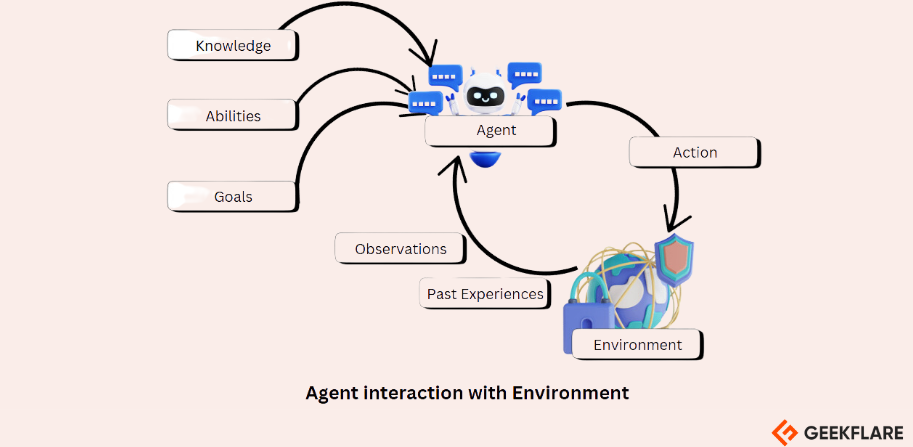
AI agents operate through architecture that involves three main components: Perception, Decision, and Action. Here’s a simple breakdown of how these work together and why AI agents are useful for modern applications.
Perception: This is how the AI agent “sees” or “senses” its surroundings. The agent collects information from its environment, which could be through physical sensors (like cameras and radar in a self-driving car) or software inputs (like customer queries in a chatbot). This input data is necessary for the agent to understand its current situation and make relevant decisions.
Decision: Based on the perceived data, the AI agent considers its options and decides on the best action to achieve its goal. Using algorithms and models, the agent interprets the input and predicts outcomes, aiming to make rational choices that maximize its effectiveness. For example, a chatbot might decide on the best response to satisfy a customer query based on previous interactions.
Action: After making a decision, the agent performs the chosen action. This could mean moving in a certain direction for a self-driving car, responding with a specific answer in a chatbot, or adjusting settings in a smart home system. This process is typically repeated in a loop, allowing the agent to adapt and respond to new information continuously.
AI agents are constantly in touch with their environment, adapting their actions based on changing data. For example, a self-driving car interacts with its surroundings by using sensors to detect obstacles, speed, and road conditions, making real-time driving decisions. Each decision informs the next, allowing it to navigate safely and efficiently even in changing traffic.
Types of AI Agents
AI agents can be classified based on their intelligence and capabilities. Here are the key types:
1. Simple Reflex Agents
Simple reflex agents act based on the current percept and use condition-action rules. They do not consider past actions or the broader context of the environment. These agents are limited in intelligence and can struggle in partially observable environments. They may fall into infinite loops if the environment changes unexpectedly.
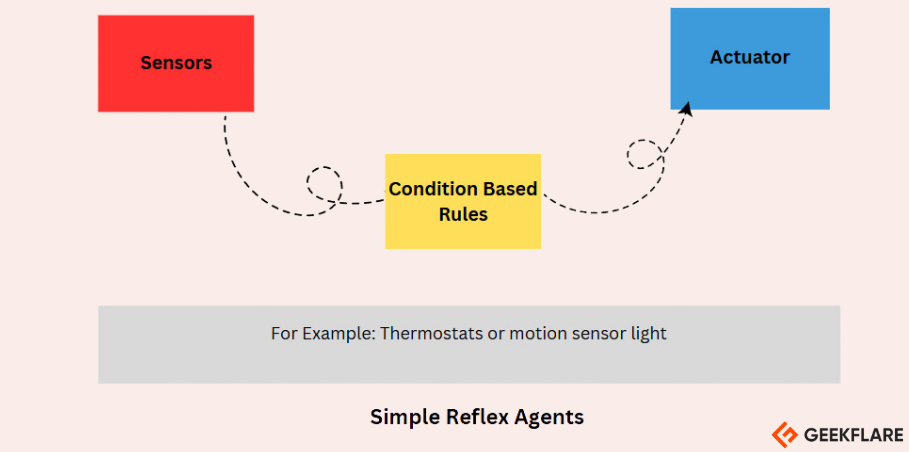
For Example, An AI agent in the AC system operates based on simple condition-based rules. The AI agent constantly monitors the temperature of the environment (Room) and simply applies these rules. If it detects the temperature is below 20°C, it turns off the AC, and if it’s above 25°C, it turns on the AC. The AI doesn’t require complex reasoning or memory. It only reacts based on the current temperature readings.
2. Model-Based Reflex Agents
A model-based AI agent works by using rules to match its actions to the current situation. It has an internal model, or “memory,” which helps it handle situations where it can’t directly see all the details.
The agent updates its internal state based on each new piece of information it receives, adjusting this memory over time. This stored state allows it to keep track of hidden parts of the environment so it can make informed decisions even when some information is missing.
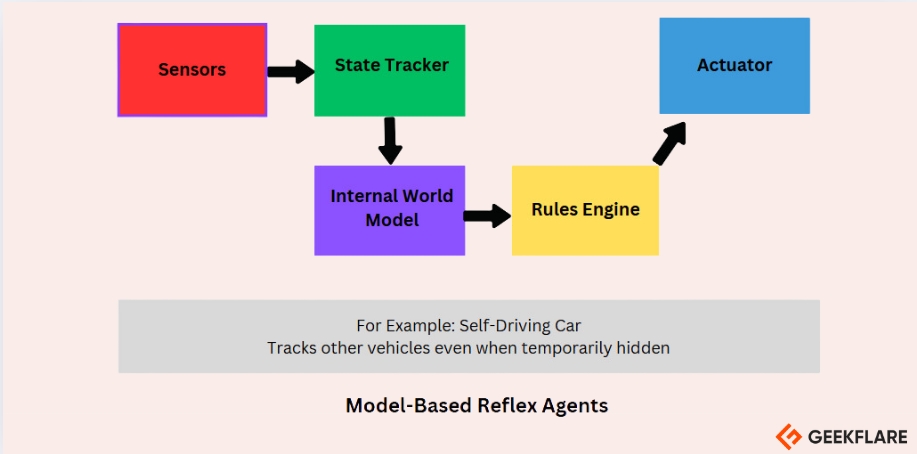
For example, The car’s sensors gather information from its environment, which includes the road, nearby vehicles, and obstacles. The state tracker keeps the car updated on its current position and situation.
Meanwhile, the internal world model helps the car remember objects that may be temporarily out of sight, like a vehicle that moves behind a truck. Based on this information, the rules engine applies specific actions, such as slowing down if another car is too close.
Finally, the actuator carries out these actions by controlling the car’s steering, brakes, and acceleration. In this setup, the car’s surroundings make up its environment, and the agent’s components work together to help it navigate and respond safely.
3. Goal-Based Agents
Goal-based agents make decisions with the aim of achieving specific goals. Their actions are planned to reduce the distance between the current state and the desired goal. These agents can adapt their behavior and select from multiple possibilities to reach their goal efficiently, requiring search and planning for flexible decision-making.
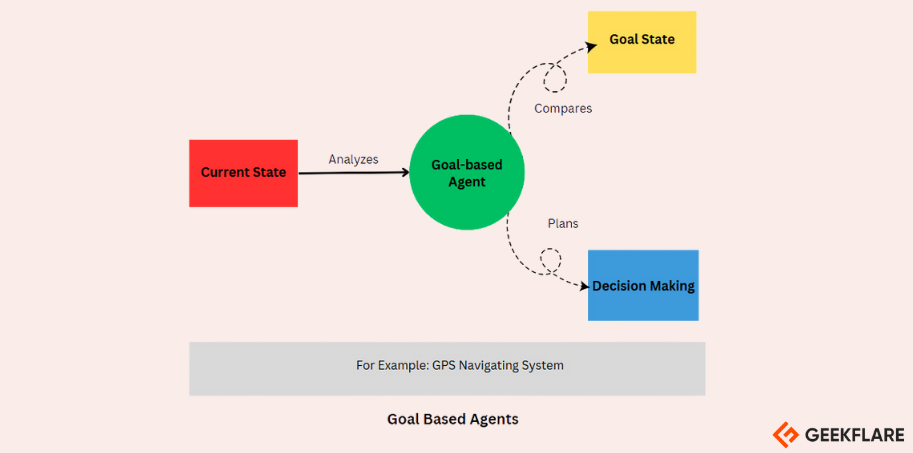
For example, a GPS navigation system finds the best route to a destination. The agent starts with a current state (the starting point) and a goal state (the destination). It compares the two to figure out the best route. The agent then makes decisions on directions to help reach the destination.
It keeps checking the current position against the goal and adjusts the route if needed. In this situation, the environment includes the roads, traffic conditions, and any obstacles or changes along the route that the GPS system must consider while guiding the user to the destination. The goal-based agent’s purpose is to guide the user from start to finish by following the plan.
4. Utility-Based Agents
Utility-based agents evaluate multiple alternatives by considering which one offers the highest utility or satisfaction. They choose actions that maximize their overall happiness or efficiency, such as choosing a faster or safer route. These agents prioritize actions based on their utility function, which measures how well a goal is achieved.
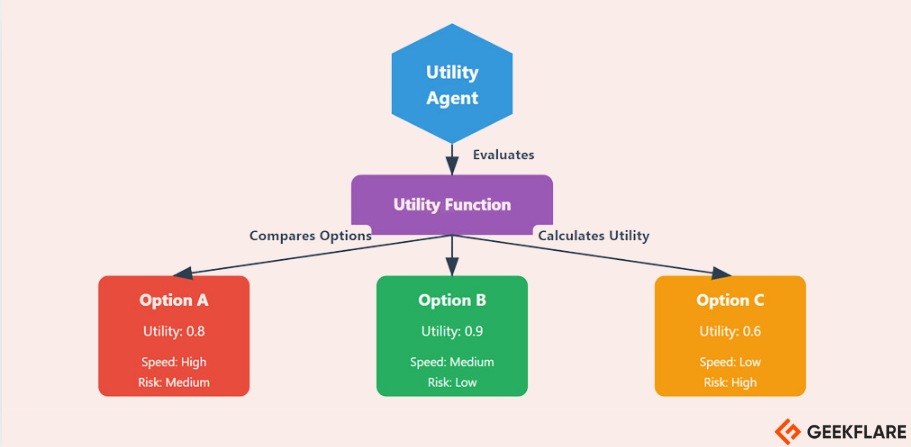
For Example, a Stock trading bot evaluates options to choose the best one. The bot, called the Utility Agent, uses a Utility Function to calculate each option’s “utility” or value based on specific factors, such as Speed and Risk. The environment is the stock market, where the bot assesses various investment opportunities and market factors.
Here, the bot has three investment options: Option A has a utility score of 0.8, high speed, and medium risk; Option B has a utility score of 0.9, medium speed, and low risk; and Option C has a utility score of 0.6, low speed, and high risk.
The bot compares these options and is likely to choose Option B because it has the highest utility score (0.9), meaning it offers a good balance of risk and return.
5. Learning Agents
A learning agent in AI is designed to improve by learning from its experiences. It starts with basic knowledge but can adapt and become more effective. This type of agent has four main parts. The learning element helps it learn and improve by interacting with its surroundings.
The critic gives feedback on the agent’s performance, guiding it to meet certain standards. The performance element decides the agent’s actions, while the problem generator suggests new actions, encouraging the agent to try different things and gain useful experiences. Together, these parts enable the agent to learn and adapt independently.
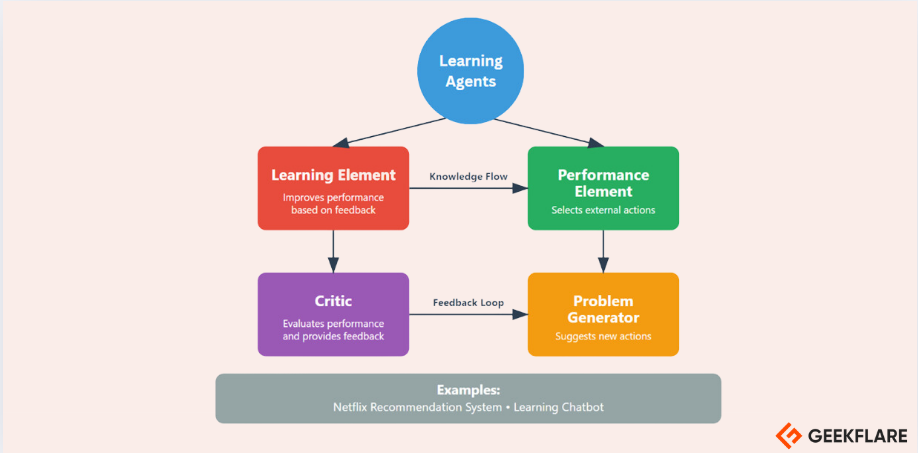
For Example, In Netflix’s recommendation system, each part of the Learning Agent plays a role in improving what content is suggested to users. The Learning Element gathers feedback from user actions, like what they watch, skip, or rate, to better understand their preferences over time.
The Performance Element uses this information to decide what shows or movies to display on the user’s homepage. The Problem Generator introduces new types of content, like suggesting a documentary to a user who usually watches comedies, to explore different interests.
Finally, the Critic evaluates how well the recommendations worked by looking at how users responded to them and provides feedback to improve future suggestions. Altogether, this process helps Netflix continuously refine its recommendations based on user behavior.
Here, the environment is the Netflix platform where users interact with the recommendations and the agent learns from these interactions.
Components of an AI Agent System
An AI agent system consists of several key components that enable it to perceive, reason, act, and learn. Here’s a breakdown of these core components:
Perception
Perception refers to the process by which an AI agent gathers information about its environment. Using sensors (such as cameras, microphones, or data feeds), an agent captures inputs, known as percepts, to understand its current state. For example, a robot may use cameras to detect obstacles, or a chatbot may receive customer queries.
Action
Once an agent senses its environment, it must take action to achieve its goals. This is done through actuators, which allow the agent to interact with its environment. For example, moving a robotic arm, sending a message, or updating a display. The choice of action is determined by the agent function, which maps sensed inputs to specific actions.
Reasoning
Reasoning is the process that allows an agent to make intelligent decisions. It involves various techniques such as:
- Condition-Action Rules: Simple reflex-based decision-making.
- Model-Based Reasoning: Maintaining an internal world model to make decisions in partially observable environments.
- Goal-Based Reasoning: Planning actions to achieve specific goals.
- Utility-Based Reasoning: Choosing actions that maximize a utility function. Advanced agents may also engage in planning to break down complex tasks into manageable subtasks.
Learning
Learning allows an AI agent to adapt and improve over time. Learning agents modify their behavior based on feedback from their environment. Techniques like machine learning and reinforcement learning help agents to learn from data or through trial and error, which improves their decision-making and ability to handle new situations.
Together, these components form the foundation of AI agents, ranging from simple reflex agents to more complex learning agents capable of adapting to dynamic environments and optimizing performance.
Applications of AI Agents
AI agents are being used across various industries, driving innovation and automation. Here are examples of how AI agents are applied in various fields:

Autonomous Vehicles
Self-driving cars depend heavily upon AI agents, for their functioning purposes. These agents use sensors like cameras and radar to analyze the surroundings by identifying elements such as vehicles, objects, and traffic signals.
AI agents analyze their surroundings to make real-time decisions about speed, route selection, and obstacle avoidance while adhering to traffic regulations. Machine learning helps these agents enhance their performance by learning from experiences and varying road conditions.
Virtual Assistants
Virtual assistants like Siri, Alexa, and Google Assistant are everyday examples of AI agents. These agents use natural language processing (NLP) to understand spoken commands and execute tasks such as setting reminders, playing music, or answering questions.
Over time, these AI agents learn user preferences and behaviors, allowing them to offer personalized, context-aware responses. This learning process improves the agent’s usefulness and accuracy, making them more intuitive and effective in meeting user needs.
Robotics
AI agents are key in robotics, helping automate tasks in manufacturing, healthcare, and logistics. In factories, they guide robots in jobs like assembly and welding, adjusting as needed. In healthcare, AI robots assist in surgeries, help with medications, and even provide companionship. These robots use sensors to understand their surroundings, make decisions, and carry out actions. Over time, they can learn from experience, becoming better at their tasks and decision-making.
Video games
AI agents are necessary to create non-player characters (NPCs) in video games, improving the gaming experience. These agents can range from simple reactive entities that follow basic behaviors to complex, adaptive agents that learn and modify their behavior based on player interactions.
They sense the game world, reason about optimal actions, and respond accordingly, providing players with a more engaging and challenging experience. Through AI, NPCs can adapt to different play styles, making each gaming session unique.
Customer Support (Chatbots)
AI chatbots are transforming customer service by providing quick assistance to users. Using advanced algorithms and NLP, these virtual assistants understand customer questions, handle common inquiries, and resolve simple issues. For more complex problems, they easily transfer the conversation to human agents, providing customers get the help they need efficiently.
Over time chatbots get better by learning from interactions which helps them improve their responses and offer assistance to users based on real-time conversations. These programs showcase the capabilities of AI agents in automating tasks and improving user interactions while increasing efficiency, in sectors of business and technology fields through their skills in understanding situations and making decisions based on acquired knowledge.
Benefits of Using AI Agents
AI agents offer several advantages for businesses and individuals by automating tasks, learning from data, and making smart decisions. Here are some of the key benefits:
Improved Productivity
Automated agents simplify tasks so that people can dedicate their attention to matters of importance instead. Such as the use of chatbots, which can address customer inquiries, making it possible for human agents to save time in resolving more complicated problems. In manufacturing, AI agents excel at executing duties, with speed and precision, resulting in improving production levels.
Reduced Cost
By automating tasks, AI agents help businesses cut costs. They reduce the need for human labor, lower payroll expenses, and work around the clock without mistakes, minimizing errors and rework. For example, AI can analyze financial data to spot fraud, preventing costly losses.
Informed Decision-Making
AI agents can process large amounts of data to uncover patterns that humans might miss. This helps businesses make smarter decisions. For example, AI can analyze customer behavior to optimize marketing strategies or help doctors diagnose health conditions by analyzing patient data.
Improved Customer Experience
AI agents improve customer service by providing prompt and customized support to users. Chatbots offer solutions to problems. Adapt to individual preferences over time to give personalized suggestions. This boosts customer happiness and loyalty, within retail settings, where AI recommends items based on prior purchases and search activity.
For Example, many e-commerce websites send personalized messages and offers to their customers based on previous orders or searches.
Challenges and Limitations of AI Agents
While AI agents offer many benefits, they also have some challenges that need to be addressed for safe and effective use. Here are the main challenges:
Ethical Concerns (Privacy, Bias)
AI agents often use large amounts of data, which can raise privacy issues. For example, if an AI agent collects personal data, like your browsing habits, and it’s not properly protected, it could be exposed to breaches. Also, if the data used to train the AI is biased, the agent might make unfair decisions.
For example, an AI used in hiring might favour certain groups if the training data shows past biases. It’s important for developers to use diverse data and protect privacy to prevent these problems.
Dependence on Quality Data
AI agents depend on high-quality data to function accurately. If the data is incorrect or incomplete, the AI can make errors. For instance, an AI assisting doctors with disease diagnosis could give wrong advice if it was trained on inaccurate data. Therefore, it’s essential to thoroughly clean and verify data to ensure the AI performs reliably.
Resource-Intensive (Computational Power)
Creating and running AI agents requires significant computing resources, especially for complex tasks, which can be costly. For example, training an AI to understand human language needs powerful computers and GPUs. This can be challenging for smaller companies due to high expenses.
Cloud computing services offer a solution by providing the necessary resources on demand, allowing companies to access advanced computing power without large upfront investments.
Security Risks
AI agents connected to networks are vulnerable to cyberattacks. Hackers could take advantage of weaknesses in the AI’s code or data, possibly gaining control or stealing sensitive information. To avoid this, strong security measures, like encryption and access controls, must be put in place.
To ensure AI agents are used responsibly, it’s important to address these challenges. As AI technology improves, it’s important to keep improving the ways we handle these issues.
Check out these best AI agents for Businesses.
Best Practices for AI Agent Management
To manage AI agents effectively, it’s necessary to follow some best practices that focus on transparency, control, security, and ethical considerations. Here are the key practices:
Activity Logs
Keeping detailed activity logs of what an AI agent does is important for transparency. These logs should record every action the agent takes, including the data it accesses and the decisions it makes. With these logs, developers and users can track the agent’s behavior, spot errors, and ensure it’s working as expected.
For example, an AI agent used for loan approvals should have logs that show which factors influenced its decision, helping ensure fairness and compliance with rules.
Interruption Capabilities
AI agents should be able to be interrupted when needed. This is especially important in cases where the agent’s actions could have serious effects, like in financial transactions or managing critical systems. There should be a way to safely stop the agent without causing harm or disruption.
For example, if an AI is controlling a power grid and its actions risk causing a blackout, operators should be able to safely interrupt it.
Unique Agent Identifiers
Assigning unique identifiers to each AI agent can improve security and accountability. These IDs allow tracking of the agent’s actions and help identify who is responsible for the agent’s behavior. This is important in systems with multiple agents, as it ensures that actions can be traced back to the correct source.
For example, if an AI agent makes an inappropriate decision in content moderation, its unique identifier can be used to identify the responsible party, promoting accountability.
Human Supervision
Although AI agents are designed to operate on their own, human supervision is still required, especially in the beginning and in sensitive situations. Having humans review the agent’s decisions and intervene when necessary helps ensure that the AI is acting ethically and responsibly.
For example, a medical AI agent might suggest a diagnosis, but a human doctor should review it before taking any action. Similarly, an AI handling stock trades might need human approval for large transactions.
Future of AI Agents
The future of AI agents looks bright, with ongoing advancements expected to significantly improve their capabilities. AI agents will become better at understanding complex instructions, learning from various data sources, and making more complex decisions.
In healthcare, they could automate tasks like analyzing patient data, providing personalized treatments, and assisting with diagnoses. In finance, AI agents could improve areas like trading, risk management, and fraud detection, as well as help individuals manage their personal finances.
As AI agents continue to evolve, they will seamlessly integrate into everyday life, managing schedules, controlling smart devices, and offering personalized recommendations. However, challenges such as ethical concerns, data privacy, and security will need to be addressed to ensure AI agents are used responsibly in society.
Conclusion
AI agents are going to be the next big thing, significantly impacting sectors such as autonomous vehicles, healthcare, robotics, and customer support. Their ability to learn, adapt, and make autonomous decisions gives exciting opportunities for efficiency and innovation.
However, careful attention to ethical concerns, privacy, and bias is necessary to ensure their safe and fair deployment. As AI agents continue to evolve, their increasing autonomy will shape industries, empowering businesses and individuals to tackle complex challenges with greater ease and intelligence.
Read More on AI
-
 EditorNarendra Mohan Mittal is a senior editor & writer at Geekflare. He is an experienced content manager with extensive experience in digital branding strategies.
EditorNarendra Mohan Mittal is a senior editor & writer at Geekflare. He is an experienced content manager with extensive experience in digital branding strategies.


